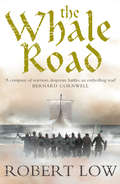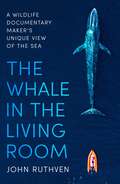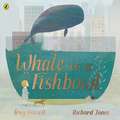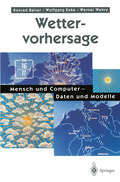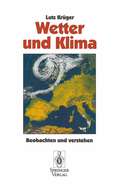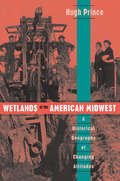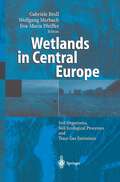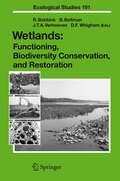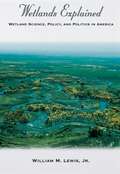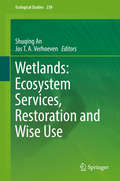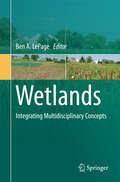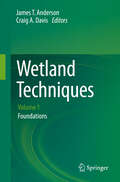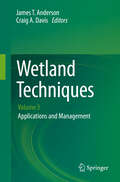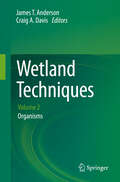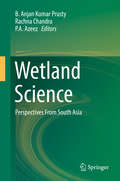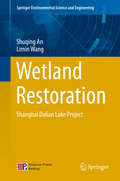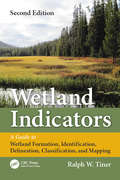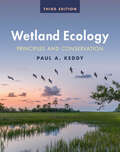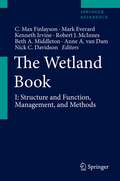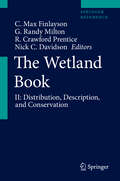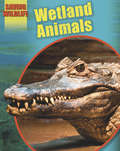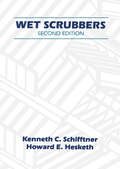- Table View
- List View
The Whale Road (The Oathsworn Series #1)
by Robert LowDISCOVER SOMETHING NEW WITH THIS LIMITED-TIME DISCOUNT ON BOOK ONE OF THE SERIES. The first in the Oathsworn series, charting the adventures of a band of Vikings on the chase for the secret hoard of Attila the Hun.
The Whale in the Living Room: A Wildlife Documentary Maker's Unique View of the Sea
by John RuthvenThe Whale in the Living Room follows the thrilling adventures of award-winning wildlife documentary producer, John Ruthven, on a journey of discovery - by turns memorable, touching and often funny -that has helped the undersea world flow into countless living rooms to reveal many of our ocean's mysteries.John is the only producer to have worked on both Blue Planet and Blue Planet II, presented by David Attenborough, in total making nearly fifty ocean films, including episodes of Discovery Shark Week, expedition films for National Geographic and coral conservation documentaries for PBS. With innovative technology he has helped capture unique images of a sperm whale mother and calf, pictures of glowing creatures half a mile deep, and grey reef sharks hunting by the light of the moon. We swim with him through blue lagoons, dive into the abyss to encounter new life forms, and experience everything from the danger of getting lost at sea to the sadness of finding a starving whale with a fishing net caught in its mouth. Through each remarkable adventure, John gives insight into what we currently know about the ocean, and our whole blue planet, revealing that the sea really is the 'saltwater country' the Yolngu people of Australia know it to be - a place with as many unique destinations in water as on land.John's book also explores why we have remained largely blind to the pollution in our oceans until recently and charts how plastic 'went wild' in the sea, to understand how we might begin to clear up the mess.
Whale in a Fishbowl
by Troy HowellWednesday is a whale who lives in a fishbowl right in the middle of a city - it's the only home she's ever known. But if she jumps high enough out of her bowl, Wednesday can see a calm bit of blue in the distance. She doesn't know what it is, but when she sees it, her heart leaps. Then one day, a little girl in a paisley dress presses her nose against the glass of Wednesday's fishbowl. 'You're lovely,' she tells Wednesday. 'But you don't belong in there.' Wednesday belongs in the sea. But what is the sea? Wednesday has never seen it. Or has she?One day she jumps higher out of her bowl than ever before and sets in motion a breath-taking chain of events that will carry her to her rightful home.Touching and uplifting, this beautiful story is about longing to be free and finding your place in the world.
Wettervorhersage: Mensch und Computer — Daten und Modelle
by Konrad Balzer Wolfgang Enke Werner WehryDrei erfahrene Meteorologen berichten ausführlich und spannend über die Meilensteine der modernen Wettervorhersage. Basis des Fortschritts ist die ununterbrochene Beobachtung atmosphärischer Vorgänge per Satellit. Super-Computer und immer perfektere physikalische Modelle simulieren die Wetterabläufe. Das Buch zeigt eindrucksvoll, was heute technisch alles möglich ist.
Wetlands of the American Midwest: A Historical Geography of Changing Attitudes (University of Chicago Geography Research Papers #241)
by Hugh PrinceHow people perceive wetlands has always played a crucial role in determining how people act toward them. In this readable and objective account, Hugh Prince examines literary evidence as well as government and scientific documents to uncover the history of changing attitudes toward wetlands in the American Midwest. As attitudes changed, so did scientific research agendas, government policies, and farmers' strategies for managing their land. Originally viewed as bountiful sources of wildlife by indigenous peoples, wet areas called "wet prairies," "swamps," or "bogs" in the late nineteenth and early twentieth centuries were considered productive only when drained for agricultural use. Beginning in the 1950s, many came to see these renamed "wetlands" as valuable for wildlife and soil conservation. Prince's book will appeal to a wide readership, ranging from geographers and environmental historians to the many government and private agencies and individuals concerned with wetland research, management, and preservation.
Wetlands of the American Midwest: A Historical Geography of Changing Attitudes (University of Chicago Geography Research Papers #241)
by Hugh PrinceHow people perceive wetlands has always played a crucial role in determining how people act toward them. In this readable and objective account, Hugh Prince examines literary evidence as well as government and scientific documents to uncover the history of changing attitudes toward wetlands in the American Midwest. As attitudes changed, so did scientific research agendas, government policies, and farmers' strategies for managing their land. Originally viewed as bountiful sources of wildlife by indigenous peoples, wet areas called "wet prairies," "swamps," or "bogs" in the late nineteenth and early twentieth centuries were considered productive only when drained for agricultural use. Beginning in the 1950s, many came to see these renamed "wetlands" as valuable for wildlife and soil conservation. Prince's book will appeal to a wide readership, ranging from geographers and environmental historians to the many government and private agencies and individuals concerned with wetland research, management, and preservation.
Wetlands in Central Europe: Soil Organisms, Soil Ecological Processes and Trace Gas Emissions
by Gabriele Broll Wolfgang Merbach Eva-Maria PfeifferWetlands are very sensitive ecosystems, functioning as a habitat for many organisms. Protection and regeneration of wetlands are of great importance in ecological research and in nature conservation. A huge amount of research has been done on the hydrology, plants and animals in wetlands. Knowledge about soil organisms and soil ecological processes of wetlands is still lacking. This knowledge is a prerequisite for landscape planning purposes or climate change predictions. In the case of climate change, trace gas emissions from wetlands are of great interest. The authors provide an overview of the state-of-the-art on soil ecology in wetlands. The book is divided into the following main chapters: 'Wetlands as habitats for soil organisms', 'Soil ecological processes in fens and floodplains', 'Carbon and nitrogen dynamics in soils with different water regimes' and 'Trace gas emissions'.
Wetlands: Functioning, Biodiversity Conservation, and Restoration (Ecological Studies #191)
by Roland Bobbink Boudewijn Beltman Jos T. A. Verhoeven Dennis F. WhighamThis book gives a broad and well-integrated overview of recent major scientific results in wetland science and their applications in natural resource management. After an introduction into the field, 12 chapters contributed by internationally known experts summarize the state of the art on a multitude of topics. The coverage is divided into three sections: Functioning of Plants and Animals in Wetlands; Conservation and Management of Wetlands; and Wetland Restoration and Creation.
Wetlands Explained: Wetland Science, Policy, and Politics in America
by William M. LewisThis book brings together in compact form a broad scientific and sociopolitical view of US wetlands. This primer lays out the science and policy considerations to help in navigating this branch of science that is so central to conservation policy, ecosystem science and wetland regulation. It gives explanations of the attributes, functions and values of our wetlands and shows how and why public attitudes toward wetlands have changed, and the political, legal, and social conflicts that have developed from legislation intended to stem the rapid losses of wetlands. The book describes the role of wetland science in facilitating the evolution of a rational and defensible system for regulating wetlands and will shed light on many of the problems and possibilities facing those who quest to protect and conserve our wetlands.
Wetlands: Ecosystem Services, Restoration and Wise Use (Ecological Studies #238)
by Shuqing An Jos T. A. VerhoevenThis volume explores major wetland ecosystem services, such as climate cooling and water quality improvement, and discusses the recent wetland conservation and restoration activities in China and neighboring countries. The role of wetlands in either cooling or warming the climate is analyzed as the net balance between carbon sequestration and emissions of methane and nitrous oxide. Wetlands start off having a net warming effect on the climate but in time switch to net cooling. Further, they remove 40% of the N and P from run-off and groundwater flow in agricultural areas, but wetlands need to amount to 10% of the total catchment area to make a difference.Reflecting on the recent large investment in wetland ecological studies in China and neighboring countries, the book addresses invasive species in coastal wetlands as well as the protection and wise use of tidal flats around the Yellow Sea. It also presents promising regional case studies on wetland restoration. The book is intended for academics, students and practitioners in the field of wetland ecology, management and restoration, as well as consultants and professionals working in conservation, wise use and environmental policy.
Wetlands: Integrating Multidisciplinary Concepts
by Ben A. LePageThe science of wetlands and our understanding of these complex ecosystems have improved considerably. The emergence of multidisciplinary strategies is providing new opportunities and innovative approaches to address issues such as climate change and coastal protection. This book, with contributions from 19 specialists from academia, government, and industry, provides a trans-disciplinary approach to the understanding wetlands science, drawing together a wide range of expertise. Topics covered include the physical aspects that shape different wetlands around the world, as well as wetlands ecology, regulation, policy, and related social and economic issues.Featuring contributions from some of the world’s leading wetlands researchers and practitioners, this book provides an invaluable resource for undergraduate and post-graduate training in all aspects of wetlands management, conservation, and construction. It is also a useful auxiliary text for researchers working across disciplines in fields such as wetlands science, law, landscape architecture, environmental engineering, conservation ecology, and related disciplines.
Wetland Techniques: Volume 1: Foundations
by James T. Anderson and Craig A. DavisWetlands serve many important functions and provide numerous ecological services such as clean water, wildlife habitat, nutrient reduction, and flood control. Wetland science is a relatively young discipline but is a rapidly growing field due to an enhanced understanding of the importance of wetlands and the numerous laws and policies that have been developed to protect these areas. This growth is demonstrated by the creation and growth of the Society of Wetland Scientists which was formed in 1980 and now has a membership of 3,500 people. It is also illustrated by the existence of 2 journals (Wetlands and Wetlands Ecology and Management) devoted entirely to wetlands.To date there has been no practical, comprehensive techniques book centered on wetlands, and written for wetland researchers, students, and managers. This techniques book aims to fill that gap. It is designed to provide an overview of the various methods that have been used or developed by researchers and practitioners to study, monitor, manage, or create wetlands. Including many methods usually found only in the peer-reviewed or gray literature, this 3-volume set fills a major niche for all professionals dealing with wetlands.
Wetland Techniques: Volume 3: Applications and Management
by James T. Anderson and Craig A. DavisWetlands serve many important functions and provide numerous ecological services such as clean water, wildlife habitat, nutrient reduction, and flood control. Wetland science is a relatively young discipline but is a rapidly growing field due to an enhanced understanding of the importance of wetlands and the numerous laws and policies that have been developed to protect these areas. This growth is demonstrated by the creation and growth of the Society of Wetland Scientists which was formed in 1980 and now has a membership of 3,500 people. It is also illustrated by the existence of 2 journals (Wetlands and Wetlands Ecology and Management) devoted entirely to wetlands.To date there has been no practical, comprehensive techniques book centered on wetlands, and written for wetland researchers, students, and managers. This techniques book aims to fill that gap. It is designed to provide an overview of the various methods that have been used or developed by researchers and practitioners to study, monitor, manage, or create wetlands. Including many methods usually found only in the peer-reviewed or gray literature, this 3-volume set fills a major niche for all professionals dealing with wetlands.
Wetland Techniques: Volume 2: Organisms
by James T. Anderson and Craig A. DavisWetlands serve many important functions and provide numerous ecological services such as clean water, wildlife habitat, nutrient reduction, and flood control. Wetland science is a relatively young discipline but is a rapidly growing field due to an enhanced understanding of the importance of wetlands and the numerous laws and policies that have been developed to protect these areas. This growth is demonstrated by the creation and growth of the Society of Wetland Scientists which was formed in 1980 and now has a membership of 3,500 people. It is also illustrated by the existence of 2 journals (Wetlands and Wetlands Ecology and Management) devoted entirely to wetlands.To date there has been no practical, comprehensive techniques book centered on wetlands, and written for wetland researchers, students, and managers. This techniques book aims to fill that gap. It is designed to provide an overview of the various methods that have been used or developed by researchers and practitioners to study, monitor, manage, or create wetlands. Including many methods usually found only in the peer-reviewed or gray literature, this 3-volume set fills a major niche for all professionals dealing with wetlands.
Wetland Science: Perspectives From South Asia
by B. Anjan Prusty Rachna Chandra P. A. AzeezThis book is an attempt to acknowledge the discipline ‘wetland science’ and to consolidate research findings, reviews and synthesis articles on different aspects of the wetlands in South Asia. The book presents 30 chapters by an international mix of experts in the field, who highlight and discuss diverse issues concerning wetlands in South Asia as case studies. The chapters are divided into different themes that represent broad issues of concern in a systematic manner keeping in mind students, researchers and general readers at large. The book introduces readers to the basics and theory of wetland science, supplemented by case studies and examples from the region. It also offers a valuable resource for graduate students and researchers in allied fields such as environmental studies, limnology, wildlife biology, aquatic biology, marine biology, and landscape ecology.To date the interdisciplinary field ‘wetland science’ is still rarely treated as a distinct discipline in its own right. Further, courses on wetland science aren’t taught at any of the world’s most prestigious universities; instead, the topics falling under this discipline are generally handled under the disciplines ‘ecology’ or under the extremely broad heading of ‘environmental studies’. It is high time that ‘Wetland Science’ be acknowledged as an interdisciplinary sub-discipline, which calls for an attempt to consolidate its various subtopics and present them comprehensively. Thus, this book also serves as a reference base on wetlands and facilitates further discussions on specific issues involved in safeguarding a sustainable future for the wetland habitats of this region.
Wetland Restoration: Shanghai Dalian Lake Project (Springer Environmental Science and Engineering #238)
by Shuqing An Limin Wang“Wetland Restoration: Shanghai Dalian Lake Project” introduces the whole Shanghai DaLian wetland restoration project, including the background investigation of the wetland, the overall planning of wetland restoration, its detailed design, engineering construction and engineering effects. This book appeals to readers especially due to its detailed data on wetland restoration. Readers can carry out a similar project step by step from the initial investigation to the last assessment by following the structure presented in this work. Through this book, we can get first-hand information on a wetland restoration, but it can also be valuable for other projects.Professor Shuqing An works at Nanjing University, China.
Wetland Indicators: A Guide to Wetland Formation, Identification, Delineation, Classification, and Mapping, Second Edition
by Ralph W. TinerUnderstand the current concept of wetland and methods for identifying, describing, classifying, and delineating wetlands in the United States with Wetland Indicators - capturing the current state of science's role in wetland recognition and mapping.Environmental scientists and others involved with wetland regulations can strengthen their knowledge about wetlands, and the use of various indicators, to support their decisions on difficult wetland determinations. Professor Tiner primarily focuses on plants, soils, and other signs of wetland hydrology in the soil, or on the surface of wetlands in his discussion of Wetland Indicators.Practicing - and aspiring - wetland delineators alike will appreciate Wetland Indicators' critical insight into the development and significance of hydrophytic vegetation, hydric soils, and other factors. Features Color images throughout illustrate wetland indicators. Incorporates analysis and coverage of the latest Army Corps of Engineers delineation manual. Provides over 60 tables, including extensive tables of U.S. wetland plant communities and examples for determining hydrophytic vegetation.
Wetland Indicators: A Guide to Wetland Formation, Identification, Delineation, Classification, and Mapping, Second Edition
by Ralph W. TinerUnderstand the current concept of wetland and methods for identifying, describing, classifying, and delineating wetlands in the United States with Wetland Indicators - capturing the current state of science's role in wetland recognition and mapping.Environmental scientists and others involved with wetland regulations can strengthen their knowledge about wetlands, and the use of various indicators, to support their decisions on difficult wetland determinations. Professor Tiner primarily focuses on plants, soils, and other signs of wetland hydrology in the soil, or on the surface of wetlands in his discussion of Wetland Indicators.Practicing - and aspiring - wetland delineators alike will appreciate Wetland Indicators' critical insight into the development and significance of hydrophytic vegetation, hydric soils, and other factors. Features Color images throughout illustrate wetland indicators. Incorporates analysis and coverage of the latest Army Corps of Engineers delineation manual. Provides over 60 tables, including extensive tables of U.S. wetland plant communities and examples for determining hydrophytic vegetation.
The Wetland Book: I: Structure And Function, Management, And Methods
by C. Max Finlayson Mark Everard Kenneth Irvine Robert J. McInnes Beth A. Middleton Anne A. van Dam Nick C. DavidsonThe Wetland Book: Ii: Distribution, Description, And Conservation
by C. Max Finlayson G. Randy Milton R. Crawford Prentice Nick C. DavidsonWetland Animals: Wetland Animals (library Ebook) (Saving Wildlife)
by Sonya NewlandWetland Animals investigates how people are working to save one of our most important ecosystems, and the millions of animals that rely on the world's wetlands for survival.It is part of the Saving Wildlife series, which investigates the world's endangered species in the context of their different environments.
Wet Scrubbers
by Howard D. HeskethA basic technical book on the design and application of gas cleaning technologies that use liquids, first published in the 1980's and used by plant and environmental engineers, regulatory personnel, and others concerned with air pollution. The second edition enlarges the discussion on the theory of
Wet Scrubbers
by Howard D. HeskethA basic technical book on the design and application of gas cleaning technologies that use liquids, first published in the 1980's and used by plant and environmental engineers, regulatory personnel, and others concerned with air pollution. The second edition enlarges the discussion on the theory of
